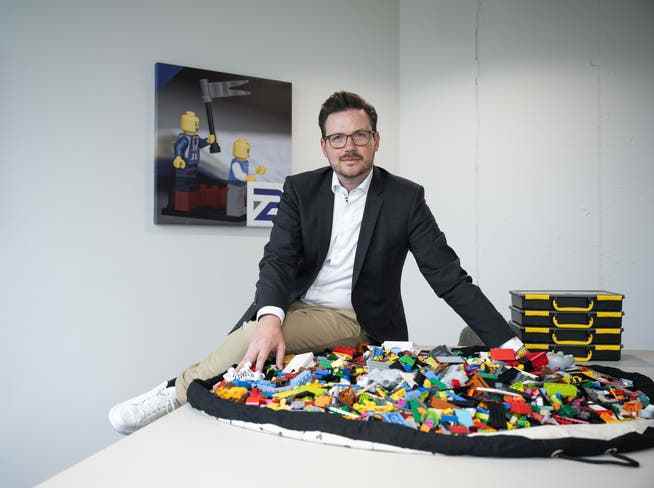Companies increasingly rely on Lego games when it comes to working out joint solutions or resolving conflicts. Are creative team building events actually effective or just token exercises?
Can Lego bricks help resolve conflicts in everyday working life?
Ten women and men in business attire are sitting in a hotel conference room, divided into smaller groups at functional conference tables. There is discussion, gesticulation, negotiation and debate. A perfectly normal meeting – if it weren’t for the Lego bricks on the table in front of them. The managers solve tasks such as “Build a tower in front of you from the individual parts and introduce yourself to your colleagues using your model”. Or: «Use the Lego bricks to illustrate your team, the cooperation and the transfer of know-how».
Shall we play Lego now seriously?
Some of the participants initially hesitate when it comes to the task at hand, and skepticism is reflected in their faces: “Are you serious – should we play Lego now?” The moderator Oliver Gabor strives to pick up the undecided team members, motivates them and challenges the group with the assigned tasks.
“Try to breathe life into the Lego parts,” he instructs the managers. “You don’t have to build a Ferrari or the Millennium Falcon, the spaceship from ‘Star Wars’. It’s enough if you can tell what your construction represents.”
The participants present the created models to each other and ask each other questions. It is argued. The individual parts are dismantled, reassembled and assembled into a larger structure towards the end of the workshop. Depending on the task at hand, the group model of managers ultimately represents a customer journey, i.e. the relationship between customers and the company and its products, as well as interaction with them, the different teams in the company or a new corporate strategy.
When Lego was threatened with demise
The methodology of the workshop is called Lego Serious Play. It was created in the mid-1990s when the then Lego boss, Kjeld Kirk Kristiansen, was looking for new methods of creative strategy development for his company. At the time, Lego was in crisis, had gone out of fashion and was slipping into the red in the face of increasing competition from Game Boy and other computer games.
Significantly involved in the development of Lego Serious Play were Robert Rasmussen, the head of product development at Lego Education at the time, and two professors from the Institute for Management Development (IMD) in Lausanne. Lego Serious Play was introduced to the public in early 2002 and is now an official Lego product line. Since 2010, so-called facilitators or moderators have been trained and certified in the method, who, like Oliver Gabor, managing director of the company Teambeschleuniger, carry out workshops on their own.

Coach Oliver Gabor encourages managers to play Lego.
When hands and brain work together
The aim of Lego Serious Play is to stimulate communication and solve problems in a playful way. The concept is based, among other things, on the knowledge that coordination between the brain and hands leads to a better understanding of problems and to pragmatic solutions. “When people have to answer a question with their hands, a lot comes to light,” explains Gabor. “When it comes to written or oral communication, we, consciously or unconsciously, hold things back.”
“In Lego Serious Play workshops, I get honest answers, sometimes almost too honest,” explains the trainer. As an example, Gabor cites the large gap that sometimes yawns between the perception of others and one’s self. «In a workshop, for example, a manager explained in detail how important his role was for the company and how many connections and contacts were linked to it. In the group’s model, however, its position was positioned at the very edge, in a corner, with just one connecting line. A contradiction that raises questions.”
The Lego Serious Play moderator is convinced that it is often about truths that are presented in a confined space. Even a management that visualizes itself sitting in a boat can say something about the prevailing group dynamics. Is the governing body pulling in the same direction? Are there outsiders? Questions to which Gabor tries to tease answers out of the group.
Increasingly popular with companies
Lego Serious Play has also arrived in the Swiss corporate world: the popularity of the workshops has increased – not least since the end of the pandemic because people want to meet physically again. Gabor’s customers include banks, the insurance group Helvetia, SMEs and the IT department of the Canton of Aargau.
The sanitary technology company Urimat Switzerland recently held a similar event with members of the board of directors and management from Switzerland and Germany. The focus was on creating a common vision, as Achim Schröter, CEO of Urimat, explains.
The company is headquartered in Hombrechtikon and has a subsidiary in Germany. The two units have diverged in recent years, says the managing director. “That’s why we wanted to bring them closer together again and optimize cooperation.” The occasion was therefore a kind of team-building event with a specific task.
Pure waste of time and money?
But in addition to donkey rides, forest bathing or running over hot coals, do we really need a Lego team event? At least for Lego, this is likely to be a lucrative business: you can quickly pay 800 francs for an “educationally high-quality set” from Lego Serious Play.
And almost anyone can be trained to become a Lego Serious Play Facilitator, even without the appropriate pedagogical or psychological training. One to four-day courses are usually sufficient for this. The quality of the courses varies accordingly. That’s why Gabor advises beginners against daring to approach sensitive topics as leaders of Lego Serious Play workshops without further training.
There are also fundamental criticisms that are leveled at such team-building events. It’s not just events like the one at the Goldbach Group that fuel skepticism: in mid-June, 13 people had to be hospitalized after a team event organized by the advertising marketer because they sustained burns during a fire walk. Collaboration researcher and author Carlos Valdes-Dapena concludes that most of the companies’ team-building activities are a waste of time and money.
During his 17-year tenure at consumer goods manufacturer Mars and his many years of research work, he has explored the question of which factors form the key to effective collaboration. Valdes-Dapena sums up his findings in one contribution for the management magazine “Harvard Business Review” as follows: Activities such as bowling evenings and a visit to a climbing park would help to strengthen group cohesion. However, the effect is very short-lived and the bond does not withstand the pressure of performance-oriented day-to-day business.
The reason for this is that the tasks and responsibilities of each individual are clearly assigned in most companies: Individual performance is rewarded by superiors and evaluation systems. Collaboration, on the other hand, is often a vague goal for which there are no concrete rules. It dilutes responsibilities and offers few rewards.
It depends on the motivation of the individual
Valdes-Dapena advises first of all to be clear within a company or group which specific tasks require cooperation. After that, employees should make a list of the behaviors they are expected to perform in order to fulfill the shared commitments. Accountability and responsibility for the joint achievement of goals should be clearly regulated.
Part of the collaboration researcher’s finding is that employees are motivated to collaborate when they can figure out for themselves how it can improve the group outcome. In his opinion, teamwork not only requires trust, but also a clear concentration on the motivation of the individual. Based on his findings, Valdes-Dapena founded his own consulting firm in 2018.
For the Lego Serious Play moderator Gabor, there is another reason why teamwork is often sluggish. In his view, one of the greatest potential for conflict is hidden expectations. These should be expressed explicitly within the group.
As an example, he mentions the presence time. If there is an implicit expectation that work should be done until around 5:30 p.m., but a member regularly leaves the office much earlier, this can lead to disagreements within the group. “Frustration and snide remarks are often the result, although it would be relatively easy to set a general attendance time in the team,” explains Gabor.
The right team composition thanks to Lego
Methods like Lego Serious Play can help to objectify the discussion. The conversation focuses on models and different males and not on individuals or “culprits,” says Livio Diem, an engineer in research and development at Dormakaba.
The company, which specializes in access and security solutions, conducted a Lego Serious Play workshop to select team members for a proposed new business unit. The aim was to allocate employees to the new group structure based on their skills and functions.
Department heads had drafted various proposals in advance, but these had met with resistance from those affected. During the workshop, a group of employees involved was given the task of using Lego figures to analyze the various group constellations and to look for the optimal solution.
Diem explains that their room for maneuver was limited by the requirements of their superiors. But the fact that the department heads stayed out of the workshop for once was positive. The fact that the employees directly affected interacted with each other and dealt with possible constellations made a significant contribution to the acceptance of the solution that had been worked out. “We went through all the alternatives and discussed the advantages and disadvantages of the different solution variants,” adds Diem. The plan presented by the team came very close to a previously worked out proposal from a department head.
Back to childhood
Schröter, the CEO of Urimat, also assesses the outcome of the workshop positively. Although the Swiss and German teams were very different culturally, they were able to agree on central points with a view to the common vision – the merging of marketing, more product innovation and the commitment to an expansion strategy. Finally, the main points were put on paper and communicated to the employees. The company is now in the implementation phase.
With Lego and the visualization you can express much more than in a “pure” discussion, says Schröter. The participants of such a workshop would have to be able to explain what their models represented and what they had in mind. You also feel freer to express your own vision, the CEO explains: “Everyone knows Lego from their childhood, the inhibition threshold is low.”
